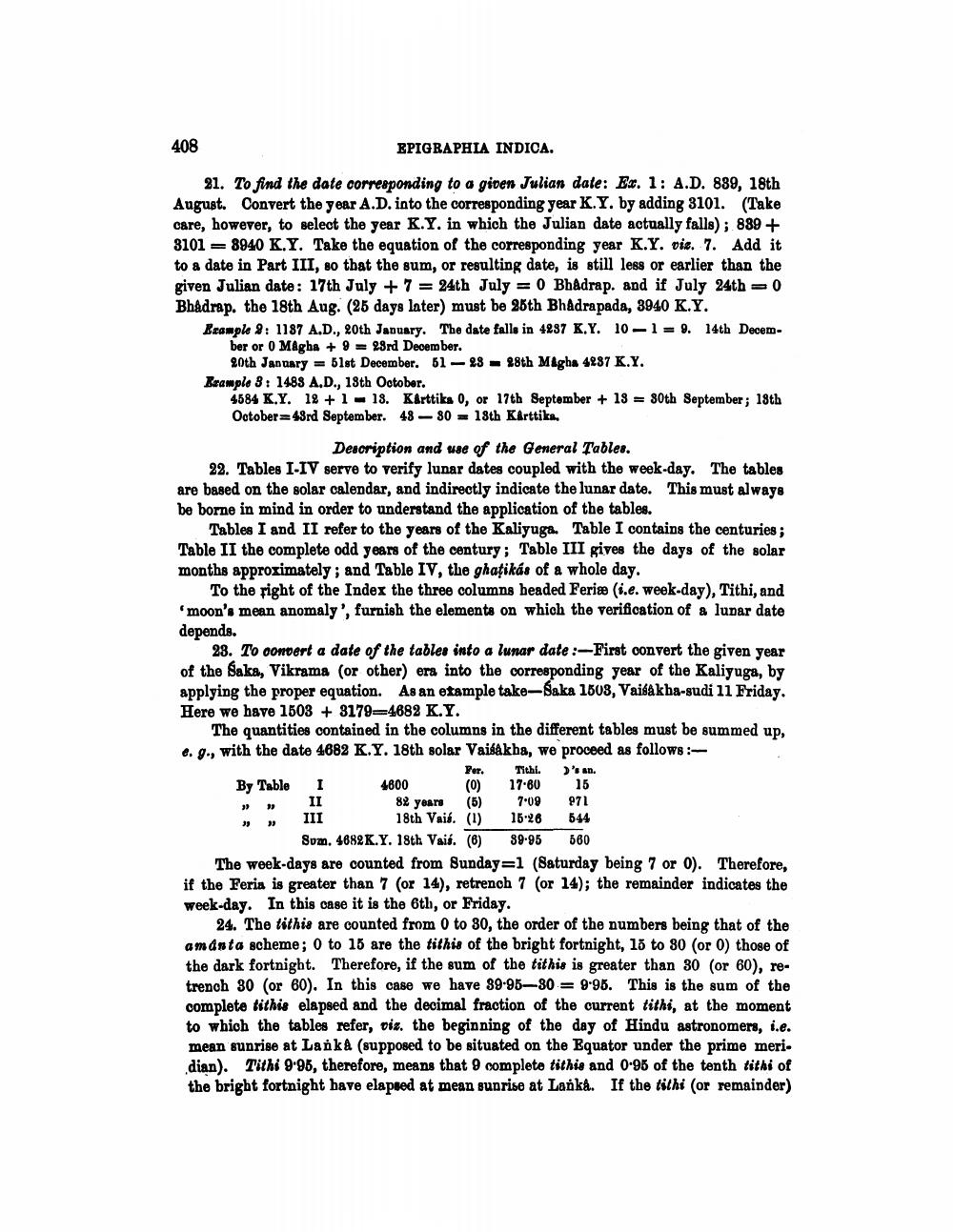________________
408
EPIGRAPHIA INDICA. 21. To find the date corresponding to a given Julian date: Ex. 1: A.D. 889, 18th August. Convert the year A.D. into the corresponding year K. Y. by adding 3101. (Take care, however, to select the year K.Y. in which the Julian date actually falls): 889 + 3101 = 8940 K.Y. Take the equation of the corresponding year K.Y. die. 7. Add it to a date in Part III, so that the sum, or resulting date, is still less or earlier than the given Julian date: 17th July + 7 = 24th July = 0 Bhadrap. and if July 24th = 0 Bhadrap. the 18th Aug. (25 days later) must be 25th Bhadrapada, 3940 K.Y. Example 8: 1187 A.D., 20th January. The date falle in 4237 K.Y. 10-1= 9. 14th Decem.
ber or 0 Magha + 9 = 23rd December.
20th January = 51st December. 51-28 - 28th Magha 4287 K.Y. Krample 3: 1488 A.D., 18th October.
4684 K.Y. 1% +1-13. Karttiks 0, or 17th September + 19 = 30th September; 18th October=43rd September. 48 - 80 = 18th Karttike.
Description and use of the General Tables. 22. Tables I-IV serve to verify lunar dates coupled with the week-day. The tables are based on the solar calendar, and indirectly indicate the lunar date. This must always be borne in mind in order to understand the application of the tables.
Tables I and II refer to the years of the Kaliyuga. Table I contains the centuries; Table II the complete odd years of the century; Table III gives the days of the solar months approximately; and Table IV, the ghaţikás of a whole day.
To the right of the Index the three columns headed Feriæ (s.e. week-day), Tithi, and moon's mean anomaly', furnish the elements on which the verification of a lupar date depends.
28. To convert a date of the tables into a lunar date :-First convert the given year of the Saka, Vikrama (or other) era into the corresponding year of the Kaliyuga, by applying the proper equation. As an etample take-Saka 1808, Vaisakha-sudi 11 Friday, Here we have 1503 + 8179=4682 K.Y.
The quantities contained in the columns in the different tables must be summed up, e. g., with the date 4682 K.Y. 18th solar Vaisakha, we proceed as follows:
Per. Tithi. )'s an. By Table 1 4800
(0) 17.80 15 82 years (5) 7.09 971
18th Vais. (1) 15.26 544 Som. 4682K.Y. 18th Vais. (6) 89-95 560 The week-days are counted from Sunday=l (Saturday being 7 or 0). Therefore, if the Feria is greater than 7 (or 14), retrench 7 (or 14); the remainder indicates the week-day. In this case it is the 6th, or Friday.
24. The tithis are counted from 0 to 80, the order of the numbers being that of the amanta scheme; 0 to 15 are the tithis of the bright fortnight, 18 to 80 (or 0) those of the dark fortnight. Therefore, if the sum of the tithis is greater than 30 (or 60), retrench 80 (or 60). In this case we have 89-95—30 = 9.95. This is the sum of the complete lithis elapsed and the decimal fraction of the current tithi, at the moment to which the tables refer, viz. the beginning of the day of Hindu astronomers, i.e. mean sunrise at Lanka (supposed to be situated on the Equator under the prime meri. dian). Tithi 9.98, therefore, means that 9 complete tithis and 0.95 of the tenth tithi of the bright fortnight have elapsed at mean sunrise at Lanka. If the tithi (or remainder)
» »
» »
II III




